Training your dog can be a fun and rewarding experience! With a few simple tips, you can improve communication with your pup and help them learn essential commands and good manners. From positive reinforcement to consistency, these strategies will set you and your furry companion up for success.
Understanding Canine Body Language

Dogs communicate a lot through their body language. Observing their posture, tail position, and facial expressions can tell you how they feel. For example, a dog with a relaxed body and wagging tail is usually happy and friendly.
The image shows a dog with bright eyes and a curious expression. This indicates that the dog is engaged and interested in its surroundings. Paying attention to these signs can help you understand your dog’s needs better.
When training your dog, recognizing these signals is key. A dog that is anxious might have its ears back or tail tucked. Understanding these cues allows you to adjust your training methods accordingly, making the process smoother for both of you.
Establishing a Consistent Routine
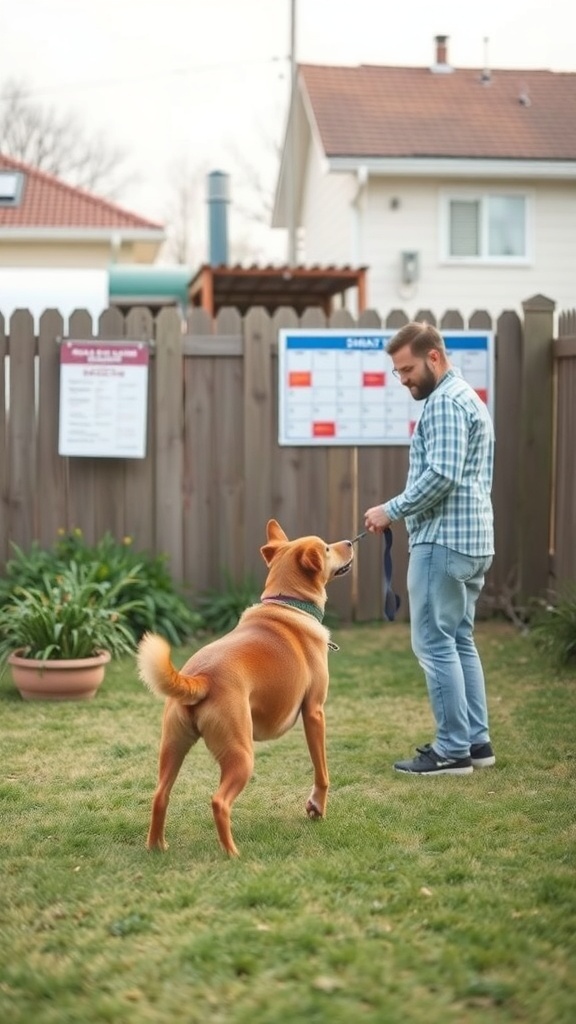
Creating a routine for your dog is key to successful training. In the image, we see a person preparing to train their dog in a backyard. This setting is perfect for establishing a routine. The dog looks attentive, ready to learn, which shows the importance of a consistent environment.
Having a designated space for training helps your dog understand when it’s time to focus. It’s great to have a plan in place. Whether it’s morning walks, feeding times, or training sessions, sticking to a schedule builds trust and helps your dog feel secure.
Using visual aids, like the training schedule on the fence, can also be helpful. It serves as a reminder for both you and your dog about what to expect each day. This consistency makes learning easier and more enjoyable for your furry friend.
Remember, patience is key. Every dog learns at their own pace. Celebrate small victories along the way. A consistent routine not only helps in training but also strengthens the bond between you and your dog.
Positive Reinforcement Techniques
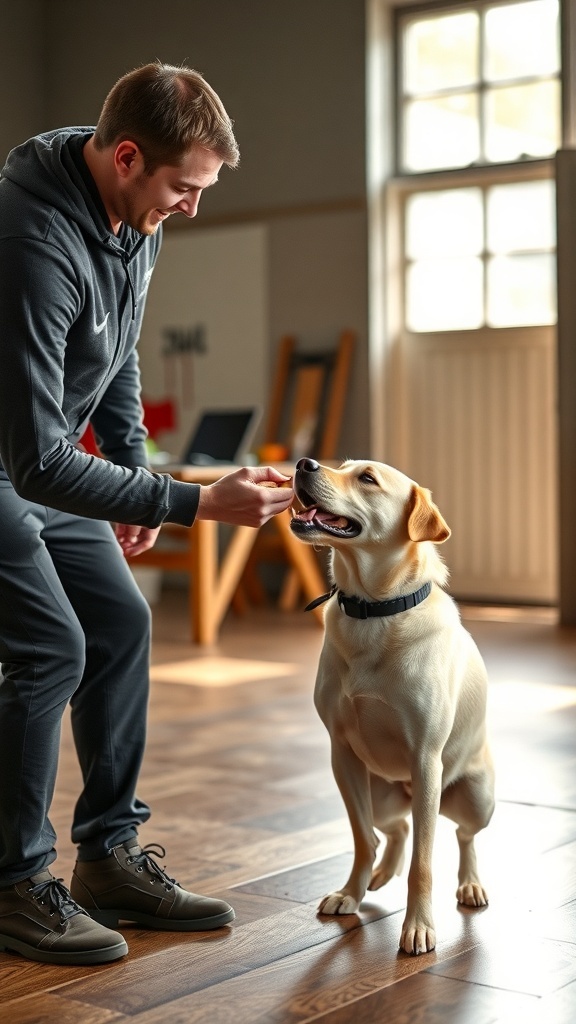
In dog training, positive reinforcement is a key method that helps dogs learn effectively. The image shows a trainer engaging with two dogs, using treats as rewards. This approach builds a strong bond between the trainer and the dogs.
When you reward your dog for good behavior, it encourages them to repeat that behavior. In the picture, the trainer is holding a treat, which clearly captures the dogs’ attention. This is a great example of how treats can motivate dogs during training sessions.
Using positive reinforcement can make training fun for both you and your dog. It’s important to choose rewards that your dog loves, whether it’s treats, praise, or playtime. The joy on the trainer’s face in the image shows how rewarding this process can be.
Consistency is key. Always reward your dog immediately after they perform the desired behavior. This helps them connect the action with the reward. The trainer in the image is likely doing just that, making the training session effective.
Basic Commands Every Dog Should Know
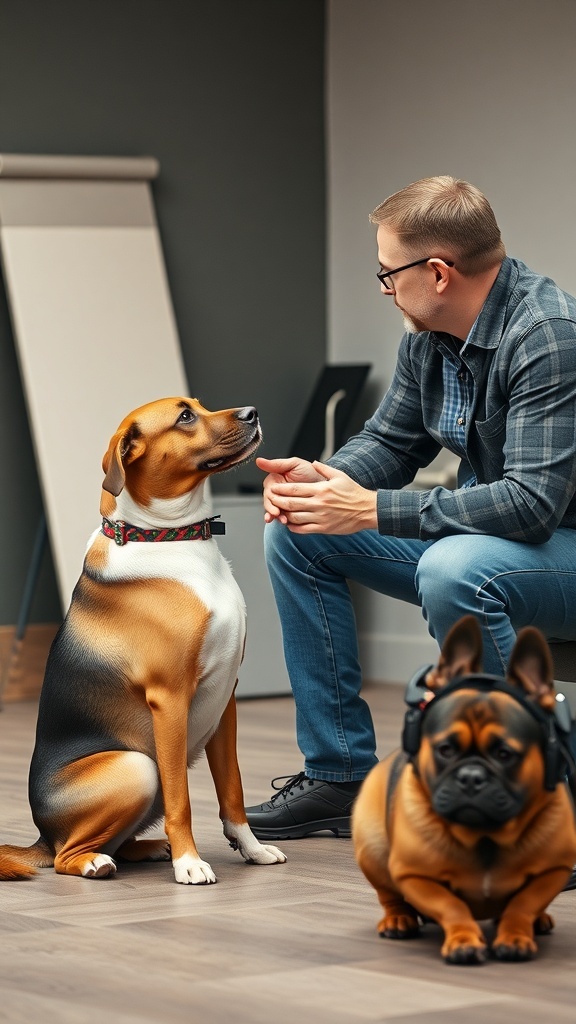
Training your dog starts with a few essential commands. These commands help build a solid foundation for good behavior. In the image, we see a trainer engaging with two dogs, showcasing the importance of interaction during training.
The first command to teach is ‘sit.’ This simple command helps your dog learn to be calm and focused. When your dog sits, reward them with praise or a treat. This positive reinforcement encourages them to repeat the behavior.
Next is ‘stay.’ This command is crucial for keeping your dog safe in various situations. Start by asking your dog to sit, then slowly back away while saying ‘stay.’ If they remain in place, reward them. This builds trust and reinforces their understanding of the command.
Another important command is ‘come.’ Teaching your dog to come when called can prevent dangerous situations. Use a happy tone and reward them when they respond. This creates a positive association with the command.
Lastly, ‘leave it’ is essential for preventing your dog from picking up harmful items. Start by showing them a treat, then say ‘leave it’ and cover the treat with your hand. When they back away, reward them with a different treat. This teaches them self-control.
Using Clicker Training Effectively
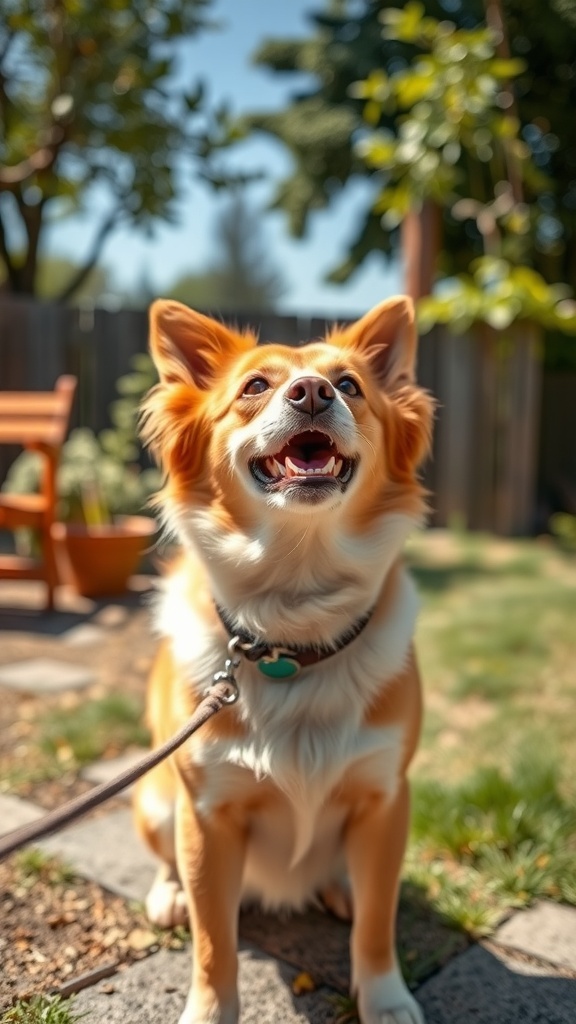
Clicker training is a fun and effective way to teach your dog new tricks. In the image, we see a happy dog, which is a great reminder of how positive reinforcement can create a joyful learning environment. The dog looks eager and engaged, showing that training can be a rewarding experience for both you and your pet.
To get started with clicker training, you’ll need a clicker and some tasty treats. The idea is simple: when your dog performs the desired behavior, you click the clicker and then give them a treat. This helps your dog associate the sound of the clicker with something good.
Make sure to keep training sessions short and fun. Dogs have short attention spans, so aim for about 5 to 10 minutes at a time. This way, your dog stays focused and excited. If they seem distracted or bored, it’s a good idea to take a break.
Consistency is key. Use the clicker every time your dog does something right. Over time, they’ll learn to repeat those behaviors to earn more treats and clicks. Remember, patience is important. Every dog learns at their own pace, so celebrate small victories along the way!
Socialization with Other Dogs
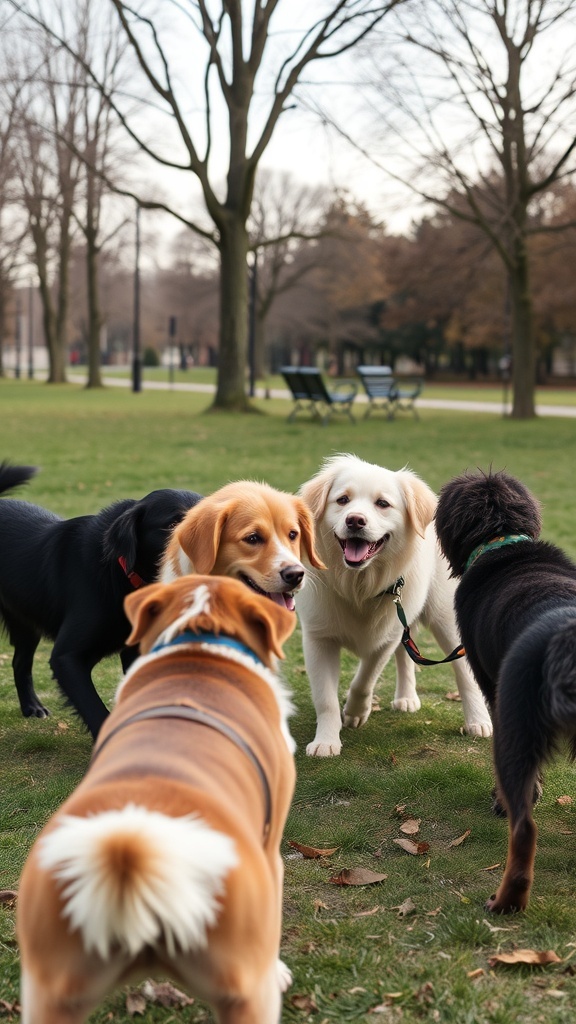
Socialization is key for your dog’s happiness and well-being. In the image, we see a group of dogs enjoying their time together in a park. This setting is perfect for dogs to interact and learn from one another. When dogs meet others, they can practice their social skills. They learn how to communicate through body language and play. This helps them become more confident and well-adjusted.
Taking your dog to a park like this can be a fun way to socialize. Make sure to supervise their interactions. Look for signs of stress or discomfort. If your dog seems overwhelmed, it’s okay to take a break. Gradually introduce them to new dogs to build their confidence.
Regular playdates with other dogs can also help. It’s a great way for them to bond and learn. Remember, every dog is different. Some may take longer to warm up than others. Be patient and let them set the pace. With time, your dog will thrive in social settings!
Dealing with Common Behavioral Issues
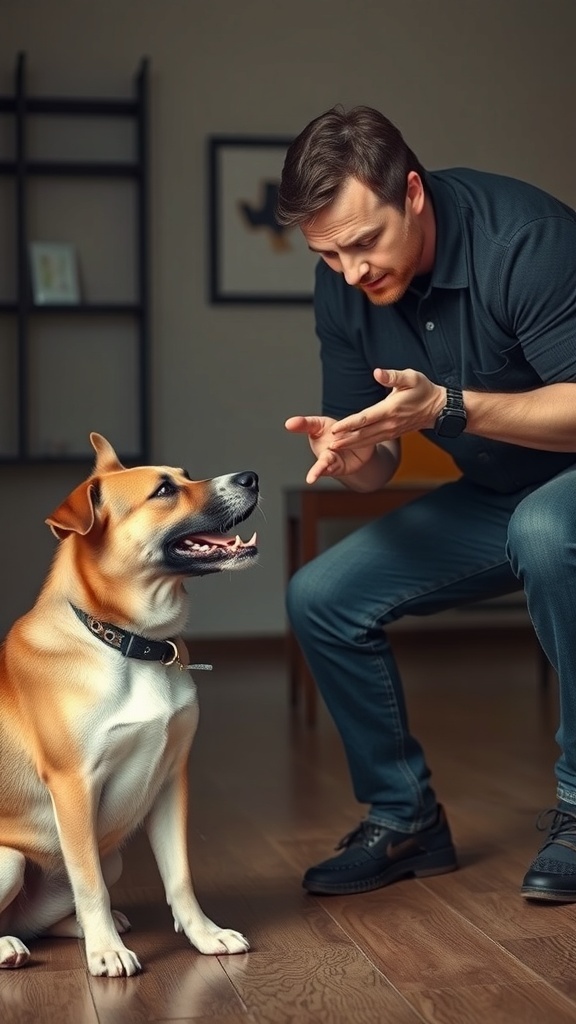
In the image, we see a trainer interacting with a dog in a training environment. The trainer is focused on the dog, who is sitting attentively. This scene captures the essence of effective dog training, where communication and understanding are key.
Common behavioral issues in dogs can often be tackled with patience and the right techniques. For instance, if your dog is barking excessively, it’s important to identify the triggers. Is it boredom, anxiety, or something else? Once you know the cause, you can work on addressing it.
Another common issue is jumping on people. Teaching your dog to sit when greeting guests can help curb this behavior. Consistency is vital. Make sure everyone in your household follows the same rules to avoid confusing your dog.
Lastly, leash pulling can be frustrating. Training your dog to walk calmly on a leash takes practice. Use treats to reward good behavior and gradually increase the distance you walk together. With time and effort, your dog will learn to walk beside you.
The Importance of Mental Stimulation
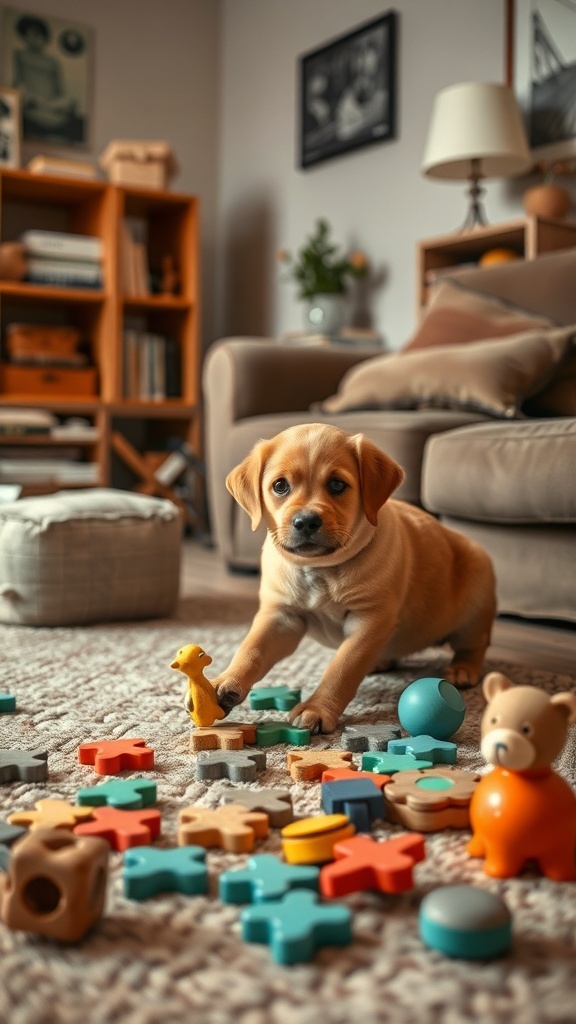
In the image, a playful puppy explores a colorful array of toys scattered on a cozy rug. This scene highlights a key aspect of dog training: mental stimulation. Just like humans, dogs need to engage their minds to stay happy and healthy.
Mental challenges can help prevent boredom, which often leads to destructive behaviors. When a dog interacts with toys that require problem-solving, they are not just having fun; they are also learning. This playful puppy is a perfect example of how engaging toys can spark curiosity and encourage exploration.
Incorporating mental exercises into your dog’s routine can be simple. Puzzle toys, interactive games, and training sessions can all provide the stimulation they crave. These activities not only keep your dog entertained but also strengthen the bond between you and your pet.
Remember, a tired dog is a happy dog. By focusing on mental stimulation, you can create a more balanced and content companion. So, next time you play with your pup, think about how you can make it a fun and challenging experience!
Incorporating Fun into Training Sessions
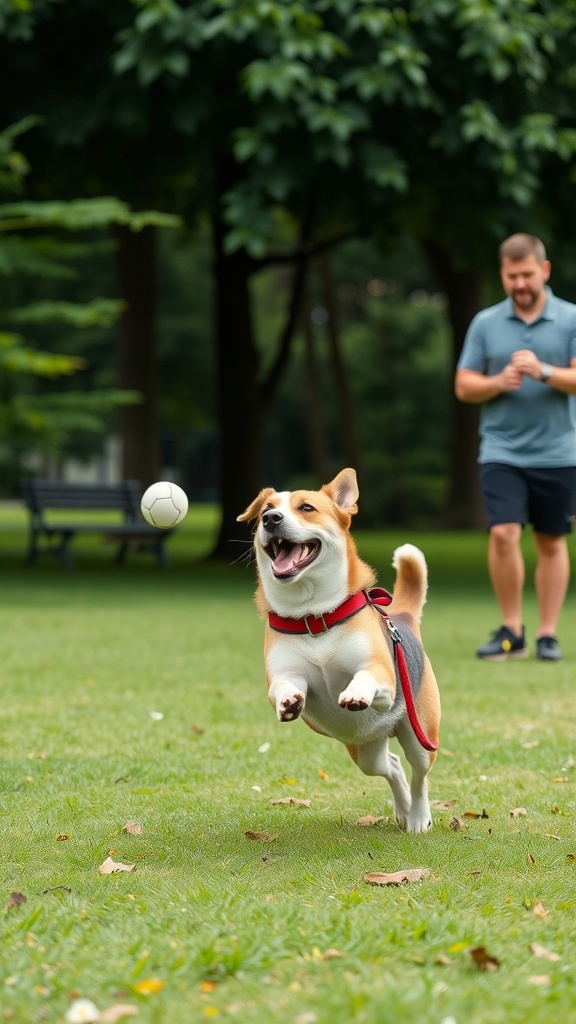
Training your dog doesn’t have to feel like a chore. In fact, it can be a blast! The image captures a joyful moment between a dog and its owner, showcasing how fun training can be. The dog is happily bounding through the grass, clearly enjoying the experience. This is the kind of energy you want to bring into your training sessions.
Start by mixing up your routine. Use games like fetch or hide-and-seek to teach commands. This keeps your dog engaged and excited. Positive reinforcement is key. Treats and praise can make a huge difference in motivation.
Also, consider the environment. Training outdoors, like in the park shown in the image, can be stimulating for your dog. The fresh air and new smells can enhance their focus. Just remember to keep sessions short and sweet to maintain their interest.
Lastly, don’t forget to celebrate small victories. Whether it’s a wagging tail or a happy bark, these moments remind both you and your dog that learning can be fun!
Setting Realistic Training Goals
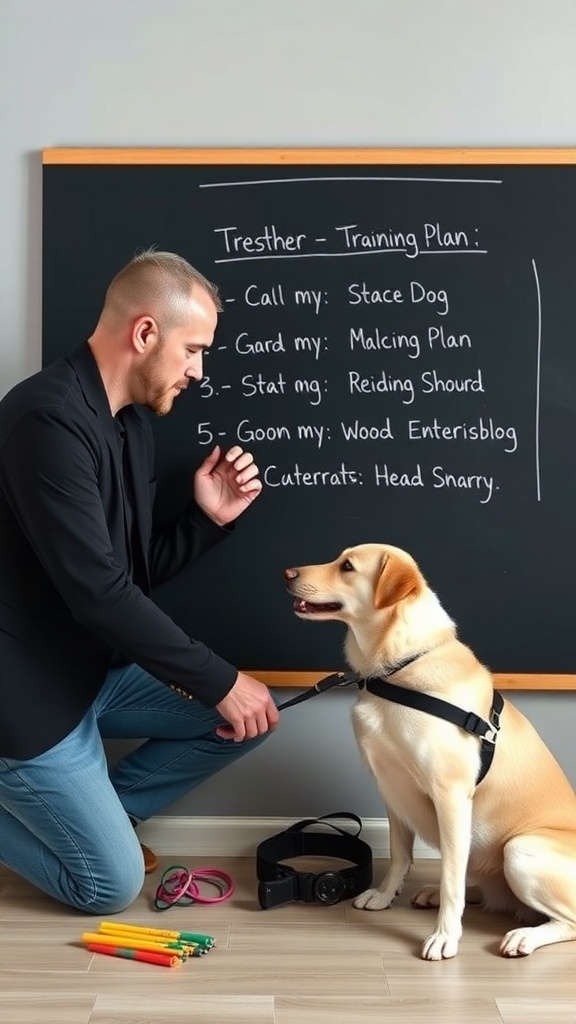
When it comes to dog training, setting realistic goals is key. The image shows a person kneeling beside a dog, looking at a chalkboard filled with a training plan. This visual highlights the importance of having a structured approach to training.
Each goal on the board represents a step in the training process. It’s essential to break down larger objectives into smaller, manageable tasks. For example, rather than aiming for your dog to master all commands at once, focus on one command at a time. This helps build confidence and keeps the training sessions enjoyable.
Also, consider your dog’s age and temperament. Young puppies may need more time to learn basic commands, while older dogs might grasp new skills faster. Tailoring your goals to fit your dog’s unique needs will make the training process smoother.
Lastly, celebrate small victories! Each time your dog learns something new, take a moment to acknowledge that progress. This positive reinforcement encourages them to keep trying. Remember, training should be a fun experience for both you and your dog.